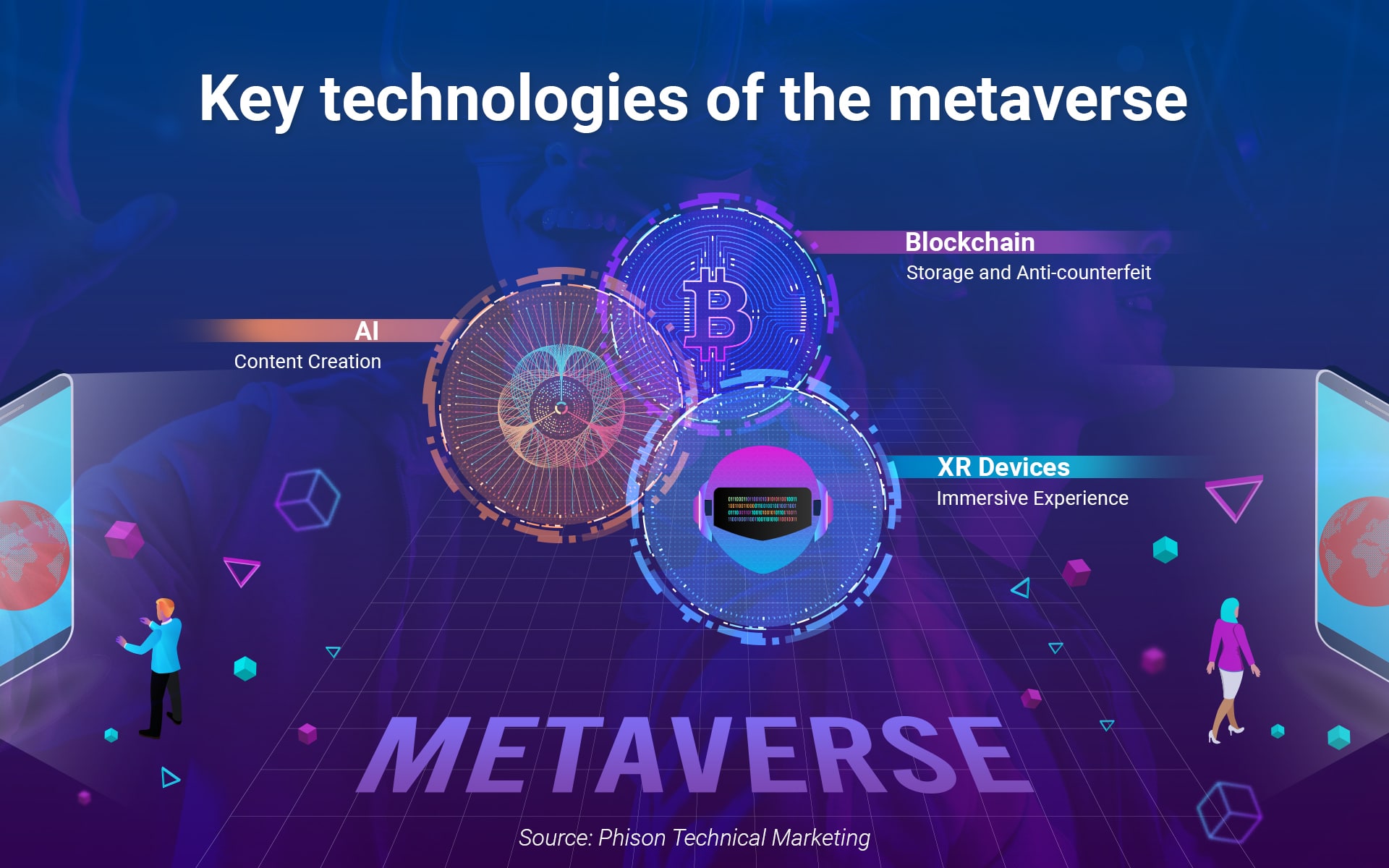The term “metaverse” was coined in Neal Stephenson’s influential 1992 novel Snow Crash, which featured a metaphysical, online world that people could enter with the use of external hardware to virtually connect and interact with others.
Since then, the concept of the metaverse in real life has evolved and expanded, and today can mean anything from massively multiplayer gaming platforms such as World of Warcraft or Second Life, to virtual reality (VR) environments for events like business meetings or social connections. The metaverse is a persistent, real-time environment that is decentralized, interoperable, and self-sustaining.
Hollywood has taken the concept and run with it, creating dazzling renditions of the metaverse in movies such as 2018’s “Ready Player One.” The film showed a completely immersive fantasy world and gaming platform that players could access through sophisticated equipment such as sensor suits, advanced VR headsets, and multi-directional treadmills for full-body movement.
While the movie’s VR hardware wasn’t real, today’s VR and augmented reality (AR) products are becoming increasingly sophisticated. Hopefully, in time we could ultimately achieve—and surpass—the incredible metaverse capabilities enjoyed by the characters in the movie.
By the end of 2021, “metaverse” had become one of the most popular tech buzzwords, as many technology giants took steps toward the concept in their marketing, branding, and product development:
- In March, gaming platform Roblox was listed on the New York Stock Exchange. The company’s end goal is to “build a human co-experience platform.”
- In April, Nvidia announced its Omniverse, a platform for “creating and connecting virtual worlds.”
- With the belief that the metaverse is the next evolution of social connection, Facebook recently changed its name to Meta.
- 10 million units of Meta’s Oculus Quest 2 headsets were sold by the end of 2021.
- Rumors about Apple’s version of the AR/VR headset say the product could be available by the end of 2022.
Key technologies of the metaverse
In the future, we could conceivably do a lot in the metaverse. More than simply a gaming platform, it could feature applications for education, business, enterprises, retail, finance, and more. While that level of experience is not yet reality, the metaverse’s many capabilities will be developed on a foundation of three key technologies: artificial intelligence (AI), blockchain, and extended reality (XR).
Artificial intelligence for content creation
In the metaverse, there will be a wealth of content to explore. Future AI will be able to create content on the fly, as needed—from a new hairstyle for your gaming avatar to a muted background for a business meeting. Today, human developers create all of those content options beforehand. Ultimately, however, AI will be critical to keeping the metaverse operating, conforming to every user’s unique and personalized demands.
Blockchain for storage and security
Consider blockchain as a digital ledger. It houses an ever-expanding list of records (or blocks) that are interconnected through advanced cryptography. The most important characteristics of the blockchain are immutability, meaning its inability to be changed, and decentralization. The most relevant metaverse-related use case is that blockchain can protect and safeguard digital assets, currency, and content and protect them from counterfeit and fraud.
XR (Extended Reality) for immersive experiences
XR is an umbrella term for immersive experience technologies and includes AR and VR. When it comes to the metaverse, XR equipment is the key medium that allows people to experience the virtual world in an immersive way. So far, the most common equipment today is the AR/VR headset.
The metaverse will run on data—and require robust storage
As the metaverse gradually becomes part of our daily life, it will generate massive volumes of data. Anyone who enters the metaverse will generate, create, and store data about every moment of their experience. Data will also take the form of near-infinite, high-quality content that will be produced in the moment as users interact and create.
This incredible amount of data will require powerful processing capabilities and robust storage solutions. As the metaverse is expected to be run in a decentralized way, the storage and the data will also be decentralized. In decentralized storage, much like blockchain, data is maintained and managed by each node. This reduces the risk of data loss, tampering, or data leakage.
Some data, however, such as offline applications, software, and device operating systems, will still need to be stored in terminal devices—in XR headsets, for example.
How much storage will be needed in this surging market? Let’s take a closer look at AR/VR headsets to find out.
Data storage in AR/VR headsets: A closer look
Global shipments of AR and VR headsets have reached new highs as the applications and hardware technologies get better and prices become more affordable. IDC expects the global shipment of AR and VR headsets to reach 50 million in 2025 with 54% of CAGR.
For AR/VR headsets, there are three types of head-mounted devices (HMD) and they each have different ways of storing data:
Screenless viewer
This type of headset is built from simple, low-cost components. It simply forms a holding mechanism and lens for the user’s smartphone, which runs the VR applications and serves up the relevant content. This headset doesn’t store any data—that all takes place in the user’s smartphone.
Tethered HMD
This type of headset is designed solely for display and sensing movement. Because it typically connects to a PC or game console, it does not include a processor or data storage.
Standalone HMD
The most complete HMD comes with a built-in processor, GPU, battery, sensor, and so on. It also includes data storage. Users are not tethered to an external device, so they have more range of movement. The Oculus Quest 2 headset is a good example of this type, which is expected to have the highest market share in the near future—up to approximately 70 percent.
The critical role of data storage in tomorrow’s metaverse
While a fully immersive metaverse isn’t available today, it will likely come sooner than some people think. Many of the world’s biggest technology companies are busy working on developing the technology and applications that will usher in a new metaverse era. As we approach that horizon, the evolution of data storage must be a priority. Phison believes that three types of data storage will be required to house and organize all of the digital content created by the virtual world:
End user device storage
There will always be a need for storage on end user devices, just like smartphones today. To support future rich AR/VR content, standalone HMDs will need large, reliable, internal storage capacity.
Centralized storage
Some light applications and games will be maintained and operated by specific operators, and that data will be stored in the cloud or on-premises servers. Most of this data will be accessed through the internet.
Decentralized storage
Most experts believe the final stage of tomorrow’s metaverse will be built on the foundation of decentralized data storage. Decentralized storage is based on blockchain technology that using open-source applications and algorithms to store sliced data to multiple independent network nodes. Unlike a centralized server operated by a single company or organization, decentralized storage systems consist of a peer-to-peer network creating a file storage sharing system with a resilient consensus mechanism and ensuring the security of all the data created in the metaverse.
Phison is well-positioned to support future data storage needs
While no one knows the exact storage capacity the future metaverse will require, it’s safe to say it will be massive. Phison Electronics is committed to developing—and defining—tomorrow’s cutting-edge NAND storage technology solutions. The company teamed up with AMD to ship the world’s first PCIe Gen 4×4 SSD and continues to be the industry’s gold standard in PCIe Gen4 SSDs. Phison will also be among the first to launch PCIe Gen5 SSD solutions in 2022. In addition to solutions for consumer and enterprise markets, Phison is also dedicated to innovating the world’s best storage solutions for embedded solutions, for applications such as VR headsets, automotive, mobile devices, and wearables. As metaverse technology develops and evolves, Phison will play a critical role in bringing XR experiences to the world.












